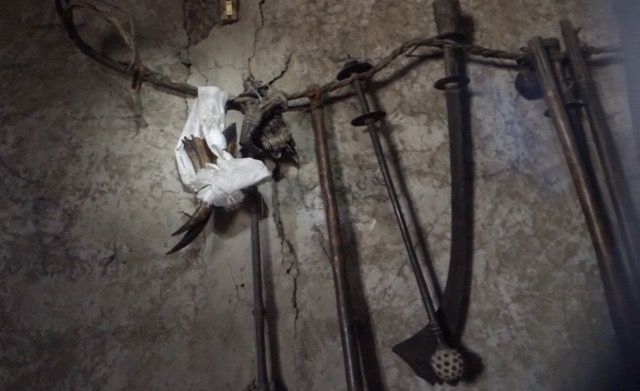In 1966, while running for the California governorship, Ronald Reagan allegedly said, when discussing the proposed national park to preserve the tall trees of Del Norte and Humboldt counties, “You’ve seen one redwood, you’ve seen them all.” What he actually said was a little more prosaic: “I mean, if you’ve looked at a hundred thousand acres or so of trees — you know, a tree is a tree, how many more do you need to look at?”
That’s how I came to feel about the Buddhist monasteries of Mustang – or the Catholic cathedrals of Europe and South America, for that matter. Yes, they all have their own unique history, their individual creation stories, their intertwinings into local lore. But in the end, they do all seem to look alike, with similar floor plans, decorations, and purpose.
But it took me a few tours of the gompas to figure this out. My first lesson involved the monks themselves. Most of them are boys and young men, aged 9-26. Prior to the late 20th century, schools as we know them in the west were non-existent on the Tibetan plateau and contiguous regions. Second-born males in many families were shipped off to the monasteries, where most of them were temporary residents, gaining an education and safety from the usual travails of male adolescence. Only a small number choose (and it is entirely voluntary) to become full-time adult monks.
All these guys need a place to live, and their quarters make up the outer perimeters of a monastery. Simple rooms with a small wooden cot, maybe a table for a book and a lamp, and a door to keep out the cold wind. Their classrooms and dining hall are nearby, all within the perimeters of a protective wall. Sometimes, agricultural plots for staples are within the compound, or nearby along the outer edges. Throughout the day, boys and young men, heads nearly shaved, roam smiling and red-robed over the grounds, heading between religious rites and daily chores. In many ways, it might be a boarding school but without the athletic fields.
Within each monastery is the chapel building, standing separate in the compound. Squat, square, nearly windowless, it is painted deep red with little external decoration. Outside the single door is often a series of prayer wheels. Steps lead up to a vestibule, where there may be a single large, possibly man-sized or bigger prayer wheel, and paintings foreshadowing the murals which cover the walls of the inner sanctuary. Depending on the age and upkeep of the gompa, these murals may be blazing bright with wildly colored pigments, or covered with the grime from centuries of tallow candles. Vaguely human creatures with scary demon faces, heads lit by dancing yellow flame, dominate the scene. Battles between the forces of light and darkness juxtapose with pastoral scenes from the life of the Buddha.
A few steps lead up to wooden doors, locked, guarding the inner sanctum of the chapel. Invariably, visitors must wait for the Key Man – usually a smiling teen-aged monk, proud to show off the local treasures.
The only light falls from above, a central opening (nowadays covered with translucent plastic) over a set of wooden benches. The room looks practical, not ornamental, with books strewn across the seats, maybe a paint bucket on the floor for trash, and prayer scarves draped over random Buddha statues. The far wall is a glassed-in showcase for the local statuary – gold (or, more likely, bronze) Buddhas of many shapes and sizes – and other treasures. Often, a smiling portrait of the Dalai Lama beams out his message of peace and happiness. Books rest in cupboards below, and to the left.
A word about these “books”. They consist of loose sheets, filled with handwriting, and kept together by a combination of a top and bottom stiff covers, often secured with twine or sash. The covers may be plain wood, or inlaid with metal scroll work and semi-precious stone. Monks will sit for hours, reading aloud or memorizing passages from religious texts. At other times, the books are consulted for medical diagnosis and treatment, or help with agriculture.
The older monks, the ones who’ve stayed into adulthood, adopt vows of poverty and in most cases celibacy. They live in the world, visiting with family, or traveling to other monasteries near and far. They are viewed as a combination of religious sage, medical shaman, and moral talisman. But they always have quarters in their home gompa, even during the winter when most will travel to lower, warmer climes.
The monastery grounds are always open. A common sight is an elder walking by the mani wall, spinning the wheels on the way to or from the day’s errands – an convenient way to pray and be blessed.
In Tsrarang, the local lore revolved around the architect of the winter palace and the central monastery. He was so revered that, after he died, his right hand was preserved, and now hangs within a musty relic room, next to swords and shields from some forgotten battle centuries ago.
Outside, the monks had gathered in an assembly hall for their mid-morning prayers. The morning stillness and cloudless sky fell on us with the counterpoint of faint drumming, deep bass chants, occasional ringing bells and one note Tibetan long horns. While I listened, I noticed laundry hanging from a second story balcony in the older monks’ quarters. The entry door was covered by a tattered brown sheet swiss-cheesed with holes. The dusty ground reflected the unfiltered sun, blinding at this altitude. Without a doubt, I was in a foreign land.






